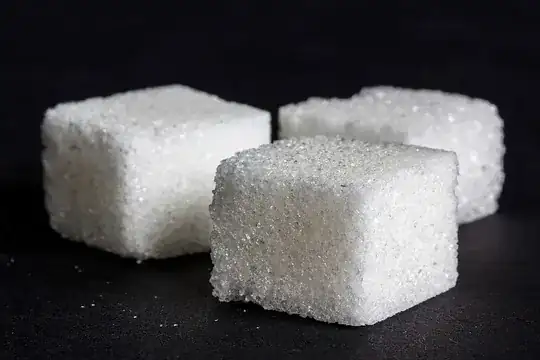Sugar cubes are polycrystalline, but not in the way the term is normally used
Sugar cubes consist of many small crystals of sucrose weakly bound together. So it is, by definition, polycrystalline. But it is not the sort of substance we normally use the term "polycrystalline" for.
Not least because sugar cubes are not really a "substance". There are lots of gaps between the crystals and they only weakly attached to each other. A pile of table salt is not very different (even when slightly damp so it forms lumps) and we don't usually feel the need to describe that as polycrystalline.
Polycrystalline is more often used for substances that are strongly bound together as the example of sandstone illustrates. Most sandstones consist of quartz or feldspar crystals strongly glued together by small amounts of other minerals. In bulk this is not obvious but under a microscope the distinct crystals can be more easily seen as can the matrix holding them together. The geological process creating sandstone is more complex than just "pressing grains together".
Other rocks are more obviously polycrystalline. Granites contain large easily visible crystals often measured in centimetres. They form when melted rock crystallises slowly and in a sequence where some minerals crystallise before others. Feldspars (the big often coloured ones that are most visible) followed by quartz and mica which form smaller crystals that bind the whole matrix into a strong rock.
But some polycrystalline substances are far less obvious. Geologists use thin sections of rock to examine less obvious structures. Thin sections viewed microscopically under polarised light can reveal situations where even a single substance is not made of single crystals but multiple crystals. The optical properties of crystals are often orientation dependent and polarised light can reveal the boundaries between otherwise similar crystals. Many things that look like single crystals turn out to be made of multiple crystals with different orientations even in apparently pure single compounds.
Another example, and one where the crystalline nature matters for the performance of the material, is seen in many metals. Iron and many steels don't appear crystalline. But most are, if the right techniques are used to visualise the internal structures. The detailed polycrystalline structures turn out to be vital for the hardness, ductility and strength of many metals and alloys. Here, understanding and manipulating the polycrystallinity of the substances is hugely important.
In short, sugar cubes are a trivial type of polycrystallinity. Mostly the term is used for more complex situations where it matters to understanding the nature of the substance.
